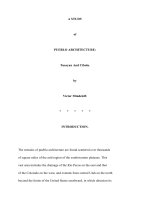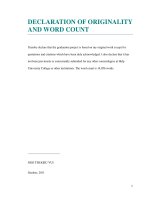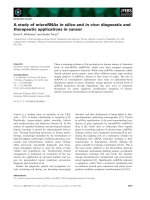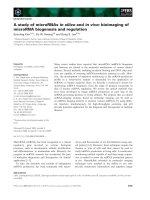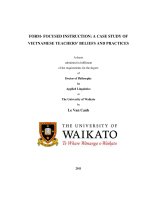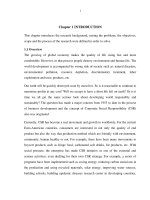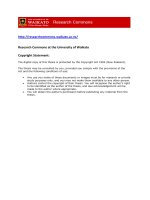Deposit insurance a study of vietnamese households knowledge and perception
Bạn đang xem bản rút gọn của tài liệu. Xem và tải ngay bản đầy đủ của tài liệu tại đây (543.64 KB, 79 trang )
MINISTRY OF EDUCATION AND TRAINING
UNIVERSITY OF ECONOMICS HOCHIMINH CITY
TRẦN THỊ HỢP
DEPOSIT INSURANCE: A STUDY
OF VIETNAMESE HOUSEHOLD’S
KNOWLEDGE AND PERCEPTION
MASTER THESIS
Ho Chi Minh City – 2012
MINISTRY OF EDUCATION AND TRAINING
UNIVERSITY OF ECONOMICS HOCHIMINH CITY
--- oOo --TRẦN THỊ HỢP
DEPOSIT INSURANCE: A STUDY
OF VIETNAMESE HOUSEHOLD’S
KNOWLEDGE AND PERCEPTION
MAJOR: FINANCE-BANKING
MAJOR CODE: 60.31.12
MASTER THESIS
SUPERVISOR: Assoc. Prof, Ph.D. TRẦN HUY HOÀNG
Ho Chi Minh City – 2012
ACKNOWLEDGE
This dissertation would not have been able complete without the support of
many people. Firstly, I wish to express my deep gratitude to my supervisor, Assoc.
Prof, Ph.D. Tran Huy Hoang for his valuable guidance and advice.
I would like to express my deepest gratitude to all instructors at Faculty of
Finance and Banking, University of Economics Ho Chi Minh City (UEH) for their
valuable knowledge during my study in UEH.
Special thanks to Dr. Vo Xuan Vinh for his useful advice for choosing a
suitable thesis’s research problem, and Master Nguyen Thanh Trung for his
enthusiastic support for this study.
My thanks and appreciations go to all my classmates, especially Ms. Pham
Thi Xuan Lien and Ms. Nguyen Hong Vinh for their comments in English editing.
I also wish to thank my friends in Techcombank, Citibank, BIDV, Maritime
Bank, Agribank, my colleagues and interviewers for their great supports. My thanks
would also go to the households that agreed to participate in the survey.
Finally, I would like to express heartfelt and deepest gratitude to my beloved
parents, my husband and my son who are encouragement for me to overcome all
difficulties through the duration of my study.
i
ABSTRACT
During the global financial crisis, many countries sought to reassure
depositors that their savings in financial institutions were safe. If depositors feel
unsure about the safety of their deposits, there is a great probability that they will
withdraw their funds when they know insured institution encounter the unsound
problems. If bank runs become widespread, it can affect the overall economy.
Therefore, public must be well informed about the benefits and limitations of
deposit insurance to build and maintain confidence in the financial system. In
addition, a well-designed public awareness program is essential in order to prevent a
bank run.
The objective of this study to investigates the knowledge about existing
deposit insurance organization in Vietnam and its basic features among a sample of
households. A study of 326 respondents was conducted in Ho Chi Minh City and
two nearby provinces. Statistics and logistic regression techniques were applied to
test hypotheses and analyze factors impacting on the public awareness of deposit
insurance. The result of the paper shows that knowledge of deposit insurance is not
widespread in Vietnam: about 60 percent of the households in the sample are
completely unaware of its existence, 30 percent possess the basic knowledge, and
only 10 percent give detailed information. The findings highlight the significant
determinants of deposit insurance awareness that are internet, education, and bank.
Keywords: Deposit insurance of Vietnam, deposit insurance, public awareness
ii
CONTENTS
ACKNOWLEDGE ................................................................................................i
ABSTRACT ......................................................................................................... ii
CONTENTS ........................................................................................................ iii
LIST OF TABLES ..............................................................................................vi
LIST OF CHARTS ........................................................................................... vii
LIST OF ABBREVIATES .............................................................................. viii
CHAPTER 1: INTRODUCTION ...................................................................... 1
1.1 Introduction ...................................................................................................1
1.2 Research background ..................................................................................... 1
1.3 Research objective ......................................................................................... 3
1.4 Research questions ......................................................................................... 3
1.5 Methodology ..................................................................................................4
1.6 Scope and limitation ....................................................................................... 4
1.7 Structure of the study ..................................................................................... 5
CHAPTER 2: LITERATURE REVIEW ........................................................... 6
2.1 Introduction ....................................................................................................6
2.2 Overview of Deposit insurance ..................................................................... 6
2.2.1
The Concept of Deposit Insurance................................................... 6
2.2.2
Objectives and role of deposit insurance ........................................ .7
2.2.3
Deposit insurance: the facts ............................................................. 8
2.2.4
Case of Deposit insurance in Vietnam ............................................. 9
2.3 Related literature ......................................................................................... 11
iii
2.3.1
Deposit insurance and public awareness ....................................... 11
2.3.2
Other efforts to investigate the public awareness .......................... 12
2.4 Developing of empirical research hypothesis .............................................. 14
CHAPTER 3: METHODOLOGY ...................................................................18
3.1 Introduction ..................................................................................................18
3.2 Research design ...........................................................................................18
3.3 Pilot test .......................................................................................................20
3.4 Main study ...................................................................................................21
3.4.1
Target audience selection ............................................................... 21
3.4.2
Sample size ....................................................................................22
3.4.3
Survey method ...............................................................................22
3.5 Data analysis techniques ..............................................................................23
3.5.1
Descriptive statistics ......................................................................23
3.5.2
Multivariate analysis ......................................................................23
CHAPTER 4: DATA ANALYSIS AND FINDINGS ...................................... 25
4.1 Introduction ..................................................................................................25
4.2 Description of collected sample ...................................................................25
4.2.1
Final sample ...................................................................................25
4.2.2
Characteristic of sample .................................................................26
4.3 Results and discussions ................................................................................27
4.3.1
Knowledge about the Vietnam DIS ............................................. 27
4.3.2
Find out determinants of awareness............................................... 32
4.3.3
The negative answers .....................................................................36
iv
4.3.4
Different level of knowledge ......................................................... 40
4.3.5
A multivariate analysis .................................................................41
4.3.6
Review the findings of the study ................................................... 45
CHAPTER 5: IMPLICATIONS AND CONCLUSION ................................. 46
5.1 Introduction ..................................................................................................46
5.2 Implications of the research .........................................................................46
5.3 Limitations of the research and further research ......................................... 49
5.4 Conclusion ...................................................................................................50
5.4.1
Summary of hypotheses .................................................................50
5.4.2
Final conclusion .............................................................................51
APPENDIX 1 - Questionnaire ..........................................................................53
APPENDIX 2 - List of financial experts and depositors ................................ 59
APPENDIX 3 - Descriptive Statistics of variables .......................................... 60
REFERENCES ........................................................................................ 67
v
LIST OF TABLES
Table 1.1 Outline of Chapter 1 ................................................................................... 1
Table 1.2 Structure of the study.................................................................................. 5
Table 2.1 Outline of Chapter 2 ................................................................................... 6
Table 2.2 The research question and all hypotheses ................................................ 16
Table 3.1 Outline of Chapter 3 ................................................................................. 18
Table 4.1 Outline of Chapter 4 ................................................................................. 25
Table 4.2 Knowledge about Vietnam deposit insurance .......................................... 28
Table 4.3 In case of bank failure, are your deposits protected in Vietnam .............. 34
Table 4.4 Omnibus Tests of Model Coefficients .......................................................... 42
Table 4.5 Model Summary ......................................................................................... 42
Table 4.6 Classification Table .................................................................................... 43
Table 4.7 Variables in the Equation ............................................................................ 43
Table 5.1 Outline of Chapter 5 ................................................................................. 46
Table 5.2 Summary of hypotheses ........................................................................... 50
vi
LIST OF CHARTS
Chart 2.1 Numbers deposit insurance in the world to March 2011 ................................... 9
Chart 2.2 The factors influence on the awareness .................................................... 17
Chart 3.1 Research process ....................................................................................... 19
Chart 4.1 Description of collected sample ................................................................ 26
Chart 4.2 Gender of respondents............................................................................... 26
Chart 4.3 Age group of respondents ......................................................................... 27
Chart 4.4 An international comparison ..................................................................... 29
Chart 4.5 Isolating the “noes” from the “don’t knows”: age .................................... 36
Chart 4.6 Isolating the “noes” from the “don’t knows”: Education ......................... 37
Chart 4.7 Isolating the “noes” from the “don’t knows”: Residence ......................... 38
Chart 4.8 Isolating the “noes” from the “don’t knows”: Risk aversion .................... 39
Chart 4.9 Isolating the “noes” from the “don’t knows”: amount of deposit ............. 39
vii
LIST OF ABBREVIATES
DI: Deposit Insurance
DIS: Deposit Insurance system
DIV: Deposit Insurance of Vietnam
FDIC: Federal Deposit Insurance Corporation
MDIC: Malaysia deposit Insurance Corporation
CDIC: Canada Deposit Insurance Corporation
IADI: International Associate Deposit insurance
DICJ: Deposit Insurance Corporation of Japan
FSF: Financial Stability Forum
BIDV: Bank for Investment and development
Agribank: Viet Nam Bank for Agriculture and Rural Development
Techcombank: Technological and Commercial Joint Stock Bank
viii
CHAPTER 1: INTRODUCTION
1.1
Introduction
This chapter represents general introduction for the current study by drawing
a general picture of the following chapter. Research background, research objective
and questions are provided as a rationale for this study. Methodology, scope and
limitations of the study are also addressed in the next sections. The last section of
this chapter introduces the structure of the study. The outline of this chapter is
shown in Table 1.1.
Table 1.1 Outline of chapter 1
1.2
1.1
Introduction
1.2
Research background
1.3
Research objective
1.4
Research questions
1.5
Methodology
1.6
Scope and limitation
1.7
Structure of the study
Research background
The stability of financial system is a key factor of a strong economy and
contributes to economic growth and development. An effective deposit insurance
system is one of pillars of a safe and sound financial system and public confidence
in the system. Public awareness of deposit insurance - its existence, and how it
works - plays an important role for the activity of deposit insurance. So public
information and awareness often are overlooked in deposit insurance system design.
1
Many countries set up deposit insurance systems have broadly publicized the terms
and conditions of deposit insurance coverage to ensure that depositors are aware of
the existence of the system and to limit the likelihood of bank runs in case of the
bank failures. It is important to ensure that depositors are aware of coverage
limitations in terms of amount and types of accounts covered in order to avoid
presumption that all deposit and other financial products are protected (FDIC –
Public awareness).
Some significant researches have directed toward examining the public
knowledge of deposit insurance. Among those substantial research in countries that
have the longer experience of deposit insurance, it can be listed out some
outstanding findings such as Inakura et al (2005) in the Japan case, and Laure
Bartiloro (2008) in the Italy case. Inakura et al (2005) find that Japanese is more
aware of deposit insurance system. Their results show that households with higher
income and educational attainment tend to be more knowledge of deposit insurance
system. While Laure Bartiloro (2008) reports that Italian knowledge of deposit
insurance is poor. The research attempted to determine the factors that affect the
awareness of deposit insurance as internet, income, and education.
Although Vietnam adopted the deposit insurance scheme later than many
other developed countries but it has been a remarkable growth. With six regional
branches were set up, deposit insurance of Vietnam has made an active contribution
to sustainable development of the banking system in Vietnam. The Vietnamese
economy and banking sector still face numerous difficulties. After the recent
financial and debt crisis, there are many banks in the world collapsed. This has
made to revive the controversy on deposit insurance and its effectiveness.
Most of the previous researches on public awareness of deposit insurance
focus on investigate the awareness of public and less attention to looking for the
determinants positive influence to the awareness. According to the author
knowledge, very few studies address the issue of public awareness of deposit
insurance in Vietnamese context. This motivates the present study to test whether
2
Vietnamese public have more widespread awareness of deposit insurance of
Vietnam. This study attempts to examine the public knowledge of deposit insurance
and relationship between the selected variables and the perception.
1.3
Research objective
As noted above, for a deposit insurance system to be effective, it is necessary
that the public be well informed about the benefits and limitation of deposit
insurance system. The recent financial crisis force policy-marker reviewing the
deposit insurance activity and changing its policy to enhance the depositors’
confidence to banking sector and ensure the safety of financial system.
This study aims to investigate the level of public awareness of deposit
insurance in Vietnam. Simultaneously, it is also searching the determinants that
appear to play a large role to the awareness of deposit insurance.
This research brings various practical meanings for the policy marker and
deposit insurer, insured institution, depositors as well as other researchers who want
to study the public awareness of deposit insurance as follows:
Firstly, the results of this research support the evidence for policy marker
and deposit insurer, insured institution fulfill the suitable policy to maintain or
enhance the public knowledge and confidence to banking system.
Secondly, the findings help the depositors know the level of security of their
deposit. In addition, they will make the right decisions to deposit or withdraw their
money to avoid the case of lack of the awareness that can lead to bank runs.
Finally, the research is able to be a reference for researchers, lectures and
students in finance and banking.
1.4
Research questions
As above discussed, this study addresses the following questions:
Q1: How is the awareness of Vietnamese public about deposit insurance?
3
Q2: What are the determinants that play a large role to the awareness of
deposit insurance?
As depositors cannot control the bank’s activities, their deposits protected by
deposit insurance system (DIS). Besides protecting depositors, the DIS also aims at
preventing panic in the banking system. If depositors believe that their deposits are
safe, they could not make a wave of withdrawal of money that lead to collapse of a
bank. Moreover, if the depositors know about the existing of deposit insurance, they
feel secure about their deposits.
The study uses two different research questions to approach the issue is that
the awareness of deposit insurance.
1.5
Methodology
This study was conducted in Ho Chi Minh City and two nearby province are
Long an and Binh Duong with two phases: a pilot study and main study.
Each country has its own characteristics of the deposit insurance scheme as
well as finance system. In the first phase, qualitative approach employed to looking
for whether the relation factors were suitable in Vietnam. This phase carries out by
using group discussion techniques. Participants are some experts who work as
executer or manage in finance – banking system. The second phase uses a
quantitative approach with convenience sample. Data is collected by interviewing
the household. SPSS software version 16.0 is used for data analysis.
1.6
Scope and limitation
The problem of public awareness in this thesis applied in deposit insurance
field in Vietnam. The first limitation of this study is in sampling. Samples were
selected by the convenience method. Therefore, it shows a low representation and
generalization is not high. A further research with larger scope of whole country
and many group target audiences is necessary to examine exactly the level of public
awareness of deposit insurance. Secondly, determinants of awareness are referenced
by the previous study. It is essential to find out the other factors may have
4
influenced the public awareness. Lastly, the scarcity of comparable papers of public
awareness and the issues of dimensionality, convergent, and discriminates validity
are one of limitations of the thesis.
1.7
Structure of the study
The structure of this study follows conventional method that divides into
chapters. Our thesis is structured into 5 chapter. Chapter 1 provides a general
introduction of the study. Chapter 2 gives a brief summary of deposit insurance and
the public awareness. Simultaneously, this chapter also discusses some related
literatures focusing on public awareness and hypothesis development. Methodology
is presented in Chapter 3. Chapter 4 describes sampling, presents the findings of the
research. Finally, Chapter 5 discusses implications, contributions and limitations of
our study and draws the conclusions.
Table 1.2 shows the structure of the study
Chapter 1
Introduction
Chapter 2
Literature review
Chapter 3
Methodology
Chapter 4
Data analysis and findings
Chapter 5
Implication and conclusion
5
CHAPTER 2: LITERATURE REVIEW
2.1
Introduction
The previous chapter introduces an overview of the study background, the
research objective, research questions, methodology and scope and limitation of this
study. This chapter provides the necessary theoretical background of deposit
insurance, its objective and role also the establishment of deposit insurance of
Vietnam. In this chapter, we also review the literature related to public awareness of
deposit insurance. The objective of this review is to propose a research model of
public awareness to generate hypotheses that will be tested in the Deposit insurance
of Vietnam to answer the research questions and to confirm the research model. The
outline of chapter 2 is shown in table 2.1
Table 2.1 Outline of chapter 2
2. 2
2.1
Introduction
2.2
Overview of deposit insurance
2.3
Related literature
2.4
Developing of empirical research hypothesis
Overview of Deposit insurance
2.2.1 The Concept of Deposit Insurance
Deposit insurance
Deposit insurance is one of the mechanisms employed by governments to
contribute to ensure the stability and soundness of banking system as well as to
protect small depositors from losses due to bank failure (Safakli and Gueyay
(2007)).
6
Maximum coverage
Most deposit insurance schemes are designed to protect only the less
sophisticated depositors and to limit the insurer’s exposure; there is usually an
upper limit on the capital certain promise
2.2.2 Objectives and role of deposit insurance
Objectives of deposit insurance
Deposit insurance considered as a mechanism of a nation’s financial safety
net that contribute the stability of credit institutions and ensure the safety and
soundness in credit institution operation by protecting the benefit of depositors.
(N.T.K.Oanh & Michael Oborn (2006)).
Choi (2000) identifies the following main objectives of deposit of insurance:
i). To protect individual depositors mainly small depositor who are less
sophisticated or those who find it hard to assess the financial conditions
of banks and their government;
ii). To contribute to the maintenance of financial system stability and make
the financial operations more efficient by preventing bank failures;
iii).To increase a competitive and fair market of credit institutions that differ
widely in size and development level in order to the reinforce the
renovation of banking operations;
iv).To clarify the responsibilities and rights of both depositors and credit
institutions;
v). To build public confidence in the deposit insurance and banking system;
and
vi).To minimize the burden on taxpayer in the case of bank failures.
The role of deposit insurance
The crucial role of deposit insurance is to support a suitable combination of
objectives that improve the quality of banking operations, maximize the attraction
7
of temporarily un-used funds from community and encourage the active participate
of the community through the principle of mutual benefit. Therefore, favorable
conditions for steady economic development can be creating. In short, the role of
the deposit insurance toward a nation can indirectly expressed through its
intermediary role in the nation’s financial system, which can summarized in the four
aspects :
i) Contributing to strengthening public confidence in national banking
system;
ii) Promoting
saving
mobilization
for
investment
and
sustainable
development;
iii) Create favorable conditions for the development of national banking
system;
iv) Contribute to prompt resolution of insolvent financial institution and
financial crisis
2.2.3 Deposit insurance: the facts
Deposit insurance (DI) was the first mentioned in the first decades of the
twentieth century and marked by the birth of Federal Deposit Insurance Corporation
(FDIC) – the world’s first organization of this kind – in the U.S in 1933. The FDIC
is an official organization set up by the US Federal government, and was created in
response to the failure of many banks during the Great Depression in the early
1930s. (Rose, 2002:42; Gonenc, 2004:13 cited in Safakli and Guryay (2007)).
It is notable that after FDIC commenced operations on 1 January 1934, other
countries followed very slowly with nine schemes being created in the years 19611969, taking to ten with FDIC. During the 1970s, more seven schemes were created
around the world. Towards the end of the 1970s and most of the 1980s, a number of
countries, mostly European, established their own systems. The majority of existing
schemes were set up in the last quarter of previous century, bringing the total to 71
8
in 1999 (Safakli and Guryay 2007). By the end of 2003 there were 87 countries
offering explicit deposit guarantees ( Demirguc-Kunt, Kan and Laeven 2006).
Explicit deposit insurance has spread rapidly in recent years, as of 31 March
2011, 111 countries have instituted some form of explicit deposit insurance and
another countries are considering.
Chart 2.1 shows numbers deposit insurance system established in the
world
1960 - 1969
1970- 1979
1980 - 1989
1990 - 1999
2000 - 3/2011
111
71
36
18
10
Sources: http://www. iadi.org/di.aspx
2.2.4 Case of Deposit insurance in Vietnam
From 1986 on, the economic reform started a new period of development of
Vietnam. The banking system changed from a centrally planned and subsidized
mechanism to independent accounting mechanism. Number of commercial banks,
rural people’s credit funds and urban people’s credit funds increased fast but many
of them went bankrupt in the years 1989-1990 and 1995-1997. Especially, the
public’s trust for financial and banking system seriously affected. The Asia
financial crisis in 1997 forced the Vietnamese banking system to carry out an
overall reform to improve its performance, competitiveness and public image. The
systemic failure of credit corporative and the Asian financial crisis show that any
9
risk requires measures to prevent and handle it (Economic development review –
July 2008).
The more the banking system integrates into the world economy, the riskier
it becomes. The preventing measures are necessary. The DI scheme is one of
financial institutions that provide such measures to limit losses and prevent the
systemic failure of banking system. To attain this purpose and support banking
system develop stably, ensure safety and stabilize the national financial sector, the
government issued Decree No 89 on Sep 1st 1999 on deposit insurance and Decision
218 of Prime Minister on Nov 9th 1999 to establish Deposit insurance of Vietnam
(DIV).
DIV is a tool for implementing the DI policy. It is a government agency with
non-profit objectives. Its appearance is an important event because it was the first
time the banking system had an institution specializing in protecting legitimate
interests and rights of depositors, maintaining stability and sound of the banking
institutions. DIV has gradually affirmed its role in the economic reform,
restructuring of the banking system. It is worth noting that in the years 1994-1996,
Bảo Việt Corporation carried out the DI in a pilot scheme but it did not produce
intended results.
DIV are governed by Decision of government and membership is mandatory
for all banks and People credit fund operating in the country. Initially, the deposit
protection scheme undertook to reimburse depositors up to a maximum amount of
VND 30 billions per depositor. Following Decree No 109 of Government on 19th
September 2005, the maximum coverage has now been increased VND 50 millions
per depositor who has account at insured institution. Deposits insured are those in
VND deposited at the insured institutions by individuals, households, cooperative
teams, private enterprises and limited partnerships companies, except some
principal case according to regulation in Decree No 109 of Government. The
insured deposit is the domestic currency. Deposits in foreign currencies are not
insured.
10
The funding of DIV comprises the following: initial funding allocated by
Government were VND 1,000 billion divided into batches with the final
installments on May 21, 2003 and insurance premiums paid by insured institutions.
The objectives of the Vietnam DIS as stated in Decision No 218 of Prime
Minister is “to protect the legitimate right and interests of depositors, making
contribution to stabilization of insured institutions and a sound and safe
development of banking system”. Moreover, DIS also fulfils its mandate is to
reimburse to the depositors in the event of bank failure, off-site supervisory and onsite examination all banks and People credit funds in the country. However, on-site
examination has also given limitation and focus to test premium collected at
depository institutions. Deposit insurance of Viet Nam institution operates under
specific regulations and is not governed by the law on financial institutions and the
law on insurance.
2.3
Related literature
2.3.1 Deposit insurance and public awareness
A moderate amount of research related to public awareness of deposit
insurance such as the study group on Deposit insurance of the Financial Stability
Forum (FSF) and International Associate Deposit insurance (IADI) affirmed the
role of public awareness for designing and developing the deposit insurance.
The Study Group on Deposit insurance of the Financial Stability Forum
(FSF) identified key attributes of an effective deposit insurance system. In addition,
public awareness is mentioned as key factor in their research “The public should be
informed of the key elements of the deposit insurance system to instill confidence
(Garcia, 2000: 7-12)”. Their study provides that public awareness is particular
important for newly established deposit insurance systems. Many countries with
established system have widely publicized the terms and conditions of DI coverage
to ensure depositors awareness to limit the probability of bank run in the case of a
bank failure. It is also important to make sure that depositors are knowledge of
coverage limitations regarding amounts and accounts types to avoid the
11
presumption that all deposits- or other financial products –a protected (Financial
Stability Form, 2001: 7-8)
According to IADI core principle in 2009, public awareness is an important
factor often overlooked in deposit insurance system design. In order for a deposit
insurance system to be effective, it is essential that the public must be informed
about the benefits and limitation of the scheme. Moreover, its characteristics should
be publicized regularly to maintain and strengthen public confidence.
The Federal deposit insurance Corporation (FDIC) paper found that a public
– awareness program designed aim to attain several objectives. Firstly, a welldesigned program can convey information to improve understanding of the concept
of deposit insurance and the main features of a country’s deposit insurance system.
In this regard, the public should be educated about what deposit insurance can and
cannot accomplish. Secondly, an effective public – awareness program also help to
restore and promote confidence in the financial system. Thirdly, a public awareness
program can help to provide vital information to depositors when insured
institutions collapse. Lastly, a well-designed public awareness program carries
benefits for officials and staff of the deposit insurer.
2.3.2 Other efforts to investigate the public awareness
The empirical studies related to this research mainly focus to investigate the
knowledge of depositors about deposit insurance. Not too many researches examine
the public knowledge of deposit insurance in the world. Steiger et al (2001) and
Kissinger (2003) are the first cases to execute two waves of a survey on deposit
insurance awareness in US in 2001 and in 2003. They conducted a survey among
households. According to Steiger et al (2001) and Kissinger (2003), a larger
percentage of households know about the existence of deposit insurance. People
aged 18 to 25 and have education less than a high school diploma was less likely to
have heard of deposit insurance. However, their studies do not consider directly the
determinants of awareness.
12
Other comparable results can be found in Inakura et al (2005) for Japan and
Safakli and Gueyay (2007) for the Republic of Turkey. The main result of Inakura
et al (2005) is that awareness is good in Japan. However, Inakura et al (2005) aslo
examine the determinants of households’ knowledge. The result shows that
households with higher level of income, more financial assets and educational
attainment tend to be more knowledge of deposit insurance system. Safakli and
Gueyay (2007) study depositor’s knowledge in the Turkish Republic of Northern
Cyprus, where a new deposit insurance system was set up in 2004. Their results
show that depositors and bank staff do not have adequate knowledge about deposit
insurance system.
Concerning knowledge about deposit insurance, Laure Bartiloro (2008)
found that Italian knowledge of deposit insurance is poor. The results highlight the
determinants of deposit insurance awareness as internet, income, and education.
Moreover, men seem to be well informed than women. Another study can be found
in Straeter et al (2008) in Germany. The result of Straeter et al (2008) study is that
there is a lack of knowledge about deposit insurance, the subjects are better
informed tend to be older and more risk averse.
We have two exceptions cases that are in Canada and in Malaysia. Canada
Deposit insurance Corporation (CDIC) and Malaysia deposit insurance Corporation
(MDIC) periodically tests the awareness among depositors. Nevertheless, analyses
of the results are not provided in a written study.
After reviewing some comparable studies in this field, it can be realized that
many works and respects are done so far on this subject. However, to the author
knowledge, there are very few researches about the awareness of deposit insurance
in developing countries, especially in Vietnam. The evidence of public awareness of
deposit insurance in Vietnam is lack in the literature. This is the impulse for the
researcher to effort investigation the public awareness of deposit insurance in
Vietnam.
13
2.4
Developing of empirical research hypothesis
Based on the empirical findings from the previous studies cited section 2.3,
this research gives the following hypothesis:
H1: Vietnamese public are well informed about the existence of the Deposit
insurance and main features of Deposit insurance of Vietnam (DIV).
Laure Bartiloro (2008) shows that people use internet, have higher level of
income and education attainment are knowledge about deposit insurance. In
addition, men seem to be better informed than women. Thomas L.Harnisch (2010)
also finds that women tend to have lower levels of financial literacy than men.
Bowen (2002) shows that older people are knowledgeable about most
financial fields.
Lusardi and Mitchell (2011) report that people living in urban areas in Russia
tend to more financially literate than those living in rural areas. In addition,
financial literacy is also higher among those who are working, and in some
countries among the self-employed, compared to those who do not work.
Thus, we hypothesis:
H2a: People who are man tend to be better informed about deposit insurance
H2b: People who are older tend to be better informed about deposit
insurance.
H2c: People who live in the inner city tend to be better informed about
deposit insurance
H2d: People who attain the high education tend to be better informed about
deposit insurance
H2e: People who are working or self-employed tend to be better informed
about deposit insurance
H2f: People who have high income tend to be better informed about deposit
insurance
14
Van Rooj et al. (2007) find that individuals who possess inadequate financial
literacy are less likely to hold stocks and are more risk averse. We hypothesis:
H2g: People who are less risk aversion tend to be better informed about
deposit insurance.
Inkuraa et al. (2005) indicates that households with more financial assets
tend to be more knowledgeable with regard to the deposit insurance scheme.
Concerning the financial assets we hypothesis:
H2h: People that have a larger amount of deposits tend to be better informed
about deposit insurance.
Additionally, we want to know whether depositors revise bank’s information
for choosing a bank for their deposit. Empirical studies that focus on factors of bank
choice show that the safety of bank is an important aspect for bank clients
(Jagelavicience et al. 2006). Hence, we hypothesis:
H2i: People choose a bank to deposit. The safety of bank influences the
awareness of deposit insurance 1.
H2k: People that use internet tend to be better informed about deposit
insurance.
Laure Bartiloro (2008) discusses on descriptive statistics that number of
household component shows poor results for respondents living alone. Moreover,
people have high financial literacy tend to better informed about deposit insurance.
Last hypotheses we address:
H2l: The awareness rises when the number of households’ component
increases.
H2m: People that have high financial literacy tend to be better informed
about deposit insurance.
1
The safety of bank addresses to the possessive form of bank (state-owned bank and commercial
joint-stock bank)
15

